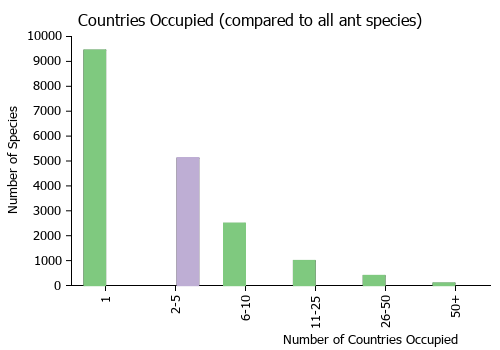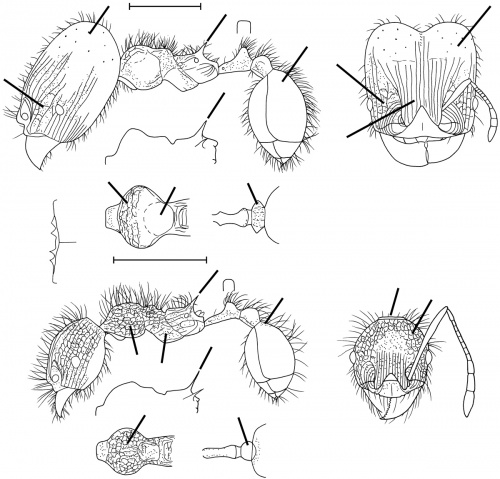Pheidole terribilis
| Pheidole terribilis | |
|---|---|
| Scientific classification | |
| Kingdom: | Animalia |
| Phylum: | Arthropoda |
| Class: | Insecta |
| Order: | Hymenoptera |
| Family: | Formicidae |
| Subfamily: | Myrmicinae |
| Tribe: | Attini |
| Genus: | Pheidole |
| Species: | P. terribilis |
| Binomial name | |
| Pheidole terribilis Wilson, 2003 | |
Nothing is known about the biology of terribilis.
Identification
See the description in the nomenclature section.
Keys including this Species
Distribution
From Wilson (2003): Known from the type locality, and 35 km south-southeast of Flor de Oro, Santa Cruz, Bolivia, 450 m, col. P. S. Ward.
Latitudinal Distribution Pattern
Latitudinal Range: 5.266667° to -12.85302778°.
| North Temperate |
North Subtropical |
Tropical | South Subtropical |
South Temperate |
- Source: AntMaps
Distribution based on Regional Taxon Lists
Neotropical Region: Bolivia, Brazil, Suriname (type locality).
Distribution based on AntMaps
Distribution based on AntWeb specimens
Check data from AntWeb
Countries Occupied
| Number of countries occupied by this species based on AntWiki Regional Taxon Lists. In general, fewer countries occupied indicates a narrower range, while more countries indicates a more widespread species. |

|
Estimated Abundance
| Relative abundance based on number of AntMaps records per species (this species within the purple bar). Fewer records (to the left) indicates a less abundant/encountered species while more records (to the right) indicates more abundant/encountered species. |

|
Biology
Castes
Nomenclature
The following information is derived from Barry Bolton's Online Catalogue of the Ants of the World.
- terribilis. Pheidole terribilis Wilson, 2003: 764, figs. (s.w.) SURINAM.
Unless otherwise noted the text for the remainder of this section is reported from the publication that includes the original description.
Description
DIAGNOSIS Similar in various traits to Pheidole horribilis, Pheidole minax, Pheidole ursus and Pheidole macromischoides, differing as follows.
Major: propodeal spine stout, about half as long as propodeal basal face; rear third of head smooth, with scattered foveae; a loose rugoreticulum between eye and antennal fossa on each side; frontal lobes and vertex carinulate; anterior half of promesonotum rugoreticulate, rear half smooth; postpetiolar dorsum foveolate and carinulate; gaster entirely smooth.
Minor: occiput and sides of head to level of eyes rugoreticulate; lower half of mesopleuron loosely rugose, and dorsum foveolate only, with rest of promesothorax rugoreticulate.
MEASUREMENTS (mm) Holotype major: HW 1.80, HL 1.86, SL 0.94, EL 0.20, PW 0.90. Paratype minor: HW 0.76, HL 0.70, SL 0.82, EL 0.14, PW 0.50.
COLOR Major: body, antennae, mandibles medium reddish brown; legs brownish yellow.
Minor: mesosoma, waist, and appendages light to medium reddish brown; head and gaster dark reddish brown.
Figure. Upper: holotype, major. Lower: paratype, minor. Scale bars = 1 mm.
Type Material
SURINAME: Voltzberg Camp, Raleigh-Vallen-Voltzberg Reserve, 90 m, col. James Carpenter and D. Trail. Museum of Comparative Zoology
Etymology
L terribilis, dreadful, frightful.
References
- Wilson, E. O. 2003. Pheidole in the New World: A dominant, hyperdiverse ant genus. Harvard University Press, Cambridge, MA. (page 764, fig. major, minor described)
- Franco, W., Ladino, N., Delabie, J.H.C., Dejean, A., Orivel, J., Fichaux, M., Groc, S., Leponce, M., Feitosa, R.M. 2019. First checklist of the ants (Hymenoptera: Formicidae) of French Guiana. Zootaxa 4674, 509–543 (doi:10.11646/zootaxa.4674.5.2).
References based on Global Ant Biodiversity Informatics
- Fernández, F. and S. Sendoya. 2004. Lista de las hormigas neotropicales. Biota Colombiana Volume 5, Number 1.
- Franco W., N. Ladino, J. H. C. Delabie, A. Dejean, J. Orivel, M. Fichaux, S. Groc, M. Leponce, and R. M. Feitosa. 2019. First checklist of the ants (Hymenoptera: Formicidae) of French Guiana. Zootaxa 4674(5): 509-543.
- Groc S., J. H. C. Delabie, F. Fernandez, F. Petitclerc, B. Corbara, M. Leponce, R. Cereghino, and A. Dejean. 2017. Litter-dwelling ants as bioindicators to gauge the sustainability of small arboreal monocultures embedded in the Amazonian rainforest. Ecological Indicators 82: 43-49.
